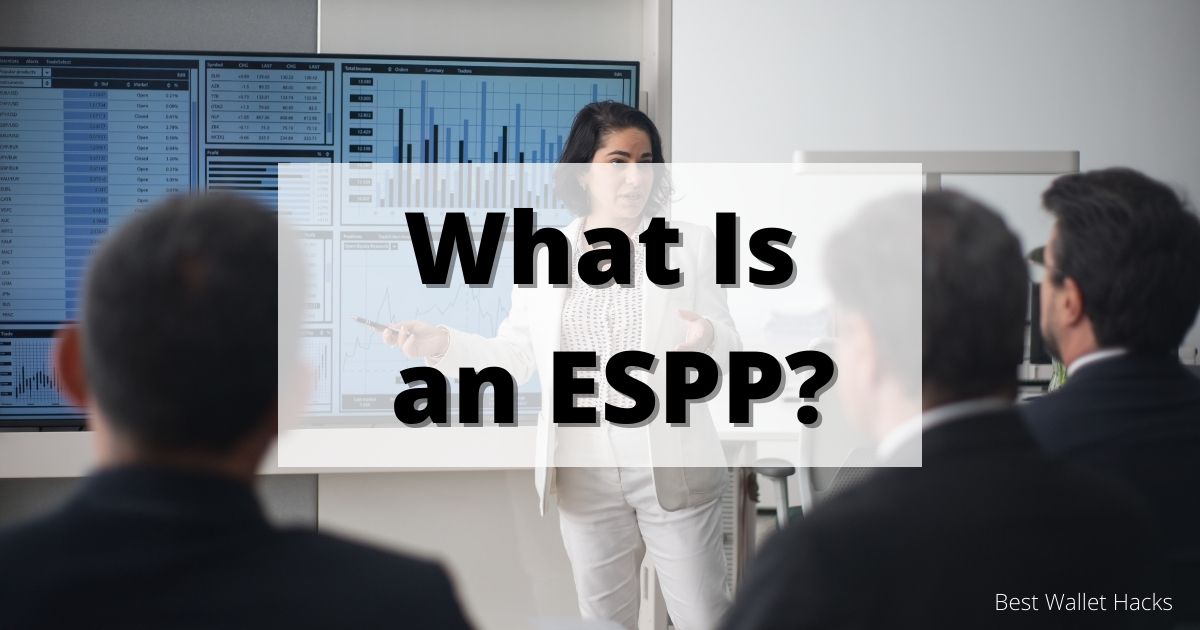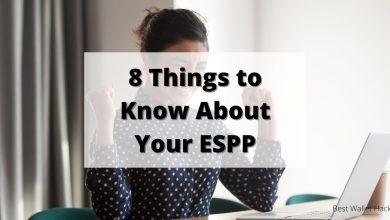What Is an ESPP and Should I Participate in One?

Some companies allow their employees to buy company stock through something known as an Employee Stock Purchase Plan, or ESPP. Employee stock purchase plans allow company stock to be sold to employees at a discount. This can generate gains for employees when the stock is sold.
Joining an ESPP is one way to increase your overall compensation from your job.
In this article, we’ll explain how ESPPs work and explain why you should participate in an ESPP if you can afford to cover the temporary loss of income.
Table of Contents
What Is an Employee Stock Purchase Plan (ESPP)?
An ESPP is a benefit program provided by some publicly traded companies. It allows their employees to purchase company stock at a discount. This discount can be as high as 15%.
The company will occasionally make discounted stock available to employees, generally every six months.
Employees contribute up to 10% of their gross pay via payroll deductions, up to $25,000 per year. This works similarly to 401(k) contributions. With each paycheck, a predetermined amount is withheld and placed into an account for use when stock is released for sale.
Employers use ESPPs as a way to encourage employees to purchase company stock. It serves to bolster the price of the stock and gives employees an incentive to work harder for the company since they will be partial owners of the business.
Once an employee purchases stock under the plan, they can choose to hold onto the shares as a long-term investment or sell for an immediate gain.
How Does an ESPP Work?
The employer can choose when and how often to release stock for sale in the ESPP. The employer will announce that stocks will be available on a certain date and payroll deductions will begin for the enrolled employees. This period of time is called the “offering period”.
Funds will build up during the offering period, and when the purchase date arrives, the stock will be automatically purchased with the funds from the account. However, the employee is not required to purchase stock and can keep the funds in the plan for future offerings. The money can also be withdrawn at any time.
The price paid for the stock can be set at either the date the offering is made, the date of purchase, or the lower of the two, as determined by the employer.
Once purchased, it’s up to the employee to decide if they want to hold it or sell it. Some plans allow for immediate sale, others require a set holding period.
Unlike an employer-sponsored retirement plan, contributions made to an ESPP are not tax-deductible, even though the contribution percentage is calculated based on pretax earnings.
ESPP Example
ABC, Inc. announces on January 1st that company stock will be available for purchases on March 31st. The stock will be offered at a 15% discount of the market value on March 31st. Thus beginning the offer period.
Enrolled employees begin to have their predetermined withholdings taken from their paychecks and set aside to purchase the company stock.
On March 31st, the stock is selling for $100. The money is taken from the employees ESPP accounts and stock is purchased at $85 per share.
If the plan allows, the employee can then immediately sell the stock for $100 each, earning a 17.6% profit. (15/85)
Qualified vs. Non-qualified ESPPs
There are two general classifications of ESPPs, qualified and non-qualified.
A qualified ESPP requires the approval of company shareholders. If the plan is qualified, the offering period must be three years or less, and the maximum share price is limited.
Non-qualified ESPPs have fewer restrictions but do not have the tax advantages offered under qualified plans.
The Tax Implications of an ESPP
As mentioned, contributions made to a plan are not tax-deductible. If your company offers an ESPP, you’ll need to consider this when determining what percentage of your income will go to a plan.
If the plan is non-qualified, you will be required to pay tax on the difference between the fair market value of the stock and the actual price you paid for it in the year you purchased the stock. In other words, you will have to pay tax on the discounted amount.
If the market price of a stock is $100 at the time of purchase, and the employee buys it for $85 (15% discount) – the dollar amount of the discount will become immediately taxable. If you purchase ten shares, the taxable gain will be $150 (the $15 per share discount X 10 shares purchased).
Under a qualified ESPP, the discount must be recognized as taxable income in the year when the stock has been sold, not when it was purchased.
Under a non-qualified plan, your employer will be required to withhold applicable federal income tax on the dollar amount of the discount of the stock purchase. There is no such withholding requirement on qualified plans.
In both cases, the discount is taxed as ordinary income, much like wages.
Capital Gains Tax on Qualified vs. Non-qualified Plans
Whether your ESPP is qualified or non-qualified, the sale of the stock purchased through the plan can generate either a capital gain or a capital loss. Either will have tax consequences.
If you sell the stock one year or less after purchase, the gain on the sale will be treated as a short-term capital gain and be subject to your ordinary income tax rates.
If it is sold more than one year after purchase, the gain will be treated as long-term and subject to lower long-term capital gains tax rates. Under current tax law, the maximum long-term capital gains tax rate is 20%, but most taxpayers will pay a lower rate.
This is also where taxes on ESPPs get complicated.
If your plan is non-qualified, the gain on sale will be calculated by the sale price of the stock, less the full price at the time of purchase. This is because you will have already paid ordinary income tax on the amount of the discount at the time you purchase the stock.
However, under a qualified plan, your basis in the stock will be the discounted price you paid for it. This may result in higher capital gains on stock purchased through a qualified plan.
Your employer is not required to withhold taxes to cover capital gains on the sale of stock purchased through an ESPP. The sale of the stock will be done on a personal level, requiring you to make tax estimates for capital gains at the time of sale.
Tax Treatment of Capital Losses
If you experience a capital loss on the sale of stock purchased through an ESPP, you can generally write off at least some of the loss. The IRS permits taxpayers to deduct the amount of capital losses incurred in a calendar year from the amount of capital gains accumulated during the same year.
You can deduct up to $3,000 as a loss for the year, with the option to carry forward losses to future years. Any amount of loss not deducted in the year incurred can be carried forward to future years. It can then be deducted against future capital gains. If there are no gains in subsequent years, the loss can continue to be deducted (up to $3,000 per year) until the loss is fully deducted.
FAQs
When should I sell my ESPP shares?
You can sell stock purchased in an ESPP at any time. If you sell immediately after purchase, you’ll profit from the difference between the price you paid for the stock – at the discounted price – and its current market value.
You can also choose to hold onto the stock in the hope of selling for a higher price later if you believe the stock’s price will rise.
Can you make money on an ESPP?
As discussed above, you can make an immediate profit on the sale of stock acquired in an ESPP by selling it immediately to take advantage of the discount paid for the stock. You could potentially make even more if you hold the stock longer and the price rises.
Can you lose money on an ESPP?
In a word, yes. While this won’t happen if you sell your shares immediately – due to the discount – it’s always a possibility if you choose to hold onto the stock.
Bottom Line: Should You Participate in an ESPP?
You should participate in an ESPP if your employer offers one. You’ll benefit immediately from the stock discount. An ESPP is like found money, similar to the employer match on employer-sponsored retirement plans.
With that said, you have to consider your personal financial situation. Since contributions to an ESPP are made with after-tax dollars, it will reduce your net income, so you should only participate in a plan up to the amount you can comfortably afford.
Other Posts You May Enjoy:
E*TRADE Bonus Promotions: up to $1,000
Did you know E*TRADE will give you cash to open a new account? See the new account brokerage bonuses they pay out for large deposits before you open your account.
TradeStation Review: Key Features, Pros and Cons
TradeStation’s in-depth research tools and trading capabilities make it a popular choice with active traders. However, new investors, or those who favor a passive investing strategy may find themselves frustrated by the complex user interface and annoying inactivity fees. Is TradeStation the right online broker for you? Find out in this TradeStation review.
What Is a Roth IRA?
A Roth IRA is a tax sheltered account that enables you to draw tax-free income in retirement. But there are contribution limits and other rules you must follow to get the most out of the account. Find out how the Roth IRA works, and how it compares to a traditional IRA account. Learn more.
Fundrise Review 2024: Commercial Real Estate Investing for Just $10
Fundrise is a private market real estate investing platform where you invest in eREITs (electronic REITs) that aren’t traded on the public markets. Which is unique since it’s usually REITS that invest in commercial real estate and crowdfunding typically invest in residential.

About Kevin Mercadante
Since 2009, Kevin Mercadante has been sharing his journey from a washed-up mortgage loan officer emerging from the Financial Meltdown as a contract/self-employed “slash worker” – accountant/blogger/freelance blog writer – on OutofYourRut.com. He offers career strategies, from dealing with under-employment to transitioning into self-employment, and provides “Alt-retirement strategies” for the vast majority who won’t retire to the beach as millionaires.
He also frequently discusses the big-picture trends that are putting the squeeze on the bottom 90%, offering workarounds and expense cutting tips to help readers carve out more money to save in their budgets – a.k.a., breaking the “savings barrier” and transitioning from debtor to saver.
Kevin has a B.S. in Accounting and Finance from Montclair State University.
Opinions expressed here are the author’s alone, not those of any bank or financial institution. This content has not been reviewed, approved or otherwise endorsed by any of these entities.




